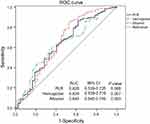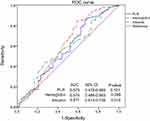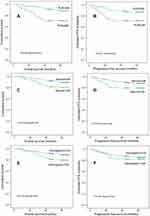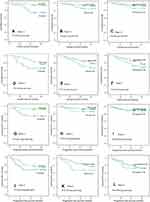Back to Journals » Cancer Management and Research » Volume 11
Prognostic values of preoperative platelet-to-lymphocyte ratio, albumin and hemoglobin in patients with non-metastatic colon cancer
Authors Li Z , Xu Z, Huang Y, Zhao R, Cui Y, Zhou Y, Wu X
Received 19 October 2018
Accepted for publication 12 March 2019
Published 16 April 2019 Volume 2019:11 Pages 3265—3274
DOI https://doi.org/10.2147/CMAR.S191432
Checked for plagiarism Yes
Review by Single anonymous peer review
Peer reviewer comments 2
Editor who approved publication: Dr Antonella D'Anneo
Zhigui Li,1 Zhaofen Xu,2 Yuqian Huang,1 Rui Zhao,1 Yaping Cui,1 Yong Zhou,1 Xiaoting Wu1
1Department of Gastrointestinal Surgery, West China Hospital, Sichuan University, Chengdu, Sichuan 610041, People’s Republic of China; 2Department of Pathology, The Second People’s Hospital, Neijiang, Sichuan 641000, People’s Republic of China
Purpose: Preoperative platelet-to-monocyte ratio (PLR), albumin and hemoglobin are suggested prognostic indicators in various malignancies. However, the prognostic values of PLR, albumin and hemoglobin remain elusive. The objective of the present study was to evaluate the prognostic values of PLR, albumin and hemoglobin in stage I-III colon cancer.
Patients and methods: A total of 312 patients with non-metastatic colon cancer undergoing curative resection were enrolled in this study. The prognostic values of PLR, albumin and hemoglobin were identified by receiver operating characteristics, and univariate and multivariate analyses.
Results: Univariate analysis revealed that preoperative PLR, albumin and hemoglobin were significantly associated with overall survival (OS) and that preoperative PLR and albumin were significantly associated with progression-free survival (PFS). Multivariate analysis revealed that preoperative PLR was significantly associated with OS.
Conclusion: Reduced preoperative PLR was significantly associated with better OS in patients with stage I-III colon cancer. Preoperative PLR was an independent prognostic indictor for OS in patients with colon cancer undergoing curative resection.
Keywords: platelet-to-lymphocyte ratio, albumin, hemoglobin, colon cancer, prognosis
Introduction
Colon cancer is one of the leading causes of cancer-related mortality worldwide, with increasing incidence and mortality.1 Curative resection was the primary cure for non-metastatic colon cancer, and 5-year survival rates ranged from 44.3% to 93.2% depending on their risk of recurrence and metastasis.2 Clinical stage and tumor differentiation are widely used to predict the clinical outcomes of colon cancer. However, a large proportion of the population with the same clinical stage and tumor differentiation exhibit different clinical outcomes. Therefore, additional prognostic indicators are needed to identify the high-risk subgroup and optimize therapeutic strategies for colon cancer.
Cumulative evidence supports that systemic inflammation is closely associated with tumorigenesis and tumor progression via the promotion of tumor proliferation, angiogenesis and migration.3–5 Based on this theory, several biomarkers of systemic inflammation, such as neutrophil-to-lymphocyte ratio (NLR),6 lymphocyte-to-monocyte ratio (LMR),7 platelet-to-lymphocyte ratio (PLR),8,9 albumin and hemoglobin, are associated with clinical outcomes. Because these biomarkers are easily obtained from preoperative routine examinations, they have attracted increasing attention. PLR was calculated as peripheral platelet count divided by lymphocyte count, which reflects the host immune response and tumor burden. Several studies demonstrated that PLR was significantly associated with clinical outcomes in various malignancies, such as breast cancer,10 lung cancer,11 and gastric cancer.12 However, other studies did not support this conclusion.13 Albumin is the most abundant plasma protein, and it plays an important role in maintaining colloid osmotic pressure. Decreased preoperative albumin levels are associated with clinical outcomes in various malignancies.14 PLR, hemoglobin and albumin are potential prognostic indicators in various malignancies, but the prognostic values of these biomarkers were not well evaluated in patients with colon cancer undergoing curative resection.
Therefore, the objective of the present study was to evaluate the prognostic values of PLR, albumin and hemoglobin in stage I-III colon cancer and to identify an accurate prognostic indicator for the predicting of clinical outcomes and optimizing therapeutic strategies.
Patients and methods
Patients
We recruited a total of 312 patients who were diagnosed with colon cancer based on pathological examination at West China Hospital from February 2012 to March 2014. The Ethics Committee of West China Hospital of Sichuan University approved this study, and all patients signed an informed consent. This study was conducted in accordance with the Declaration of Helsinki. The present study used the following enrolment criteria: (1) all patients had non-metastatic disease; (2) all patients underwent curative resection; (3) patients did not receive preoperative antitumor treatment, such as chemotherapy or radiotherapy; (4) all patients had complete medical records and laboratory data; and (5) survival time exceeded 3 months. The following exclusion criteria were applied: (1) alive with a follow-up of <3 months; (2) medical history of haemopathy or synchronous malignancy; or (3) with metastasis, recurrent colon cancer, or multifocal lesions.
Methods
We retrospectively extracted clinical characteristics from medical records, such as age, gender, clinical stage, tumor location, differentiation, and medical history. Clinical stage was determined according to the 7th edition of the American Joint Committee on Cancer (AJCC) staging system. Preoperative routine examination, including platelet count, lymphocyte count, albumin and hemoglobin, were performed within one week before curative resection. PLR was calculated as peripheral absolute platelet count divided by absolute lymphocyte count. All patients were regularly followed up at the first month after surgery, every 3 months during the following 3 years, and every 6 months in subsequent years. Overall survival (OS) was calculated from the date of surgery to the date of death by any cause. Progression-free survival (PFS) was calculated from the date of surgery to the date of recurrence or metastasis. The last follow-up date was the end of October 2017.
Statistical analysis
We used SPSS 19.0 software (SPSS, Inc., Chicago, IL, USA) to perform all statistical analyses. A two-sided P-value less than 0.05 was considered statistically significant. Categorical variable data were presented as a frequency or rate. Continuous variable data were presented as the median with quartile range or the mean with 95% confidence interval (CI). Receiver operating characteristic (ROC) curve analysis was performed to quantify the area under the ROC curve (AUC). An independent-samples t-test or a nonparametric test was performed to compare continuous variables between different groups. The chi-square test was performed to compare categorical data. The Kaplan–Meier method with a log-rank test was used to perform univariate analysis. The hazard ratio (HR) and 95% CI estimated from the multivariate Cox analysis were reported.
Results
A series of 312 patients were enrolled in the present study. Baseline characteristics of all patients are presented in Table 1. There were 176 (56.4%) males and 136 (43.6%) females, with a median age of 62 years (range 19–94). The median follow-up period was 49 months (range 4–69). The mean values of preoperative PLR, albumin and hemoglobin were 158.4 (119.5–220.4), 38.9 (35.6–42.3) and 111.0 (85.0–129.0), respectively. During the follow-up period, 42 (13.5%) patients died, and 48 (15.4%) patients experienced tumor recurrence. The one-, three- and five-year OS rates of the 312 patients were 97.4%, 91.9% and 86.5%, respectively. The one-, three- and five-year PFS rates of 312 patients were 94.2%, 85.9% and 84.6%, respectively.
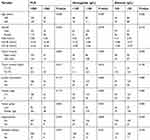 | Table 1 Baseline characteristics of patients with colon cancer |
ROC curves were performed to evaluate the clinical utilities of PLR, albumin and hemoglobin. The AUC for OS in PLR, albumin and hemoglobin was 0.628 (P=0.008), 0.644 (P=0.003) and 0.629 (P=0.007), respectively (Figure 1). The AUC for PFS in PLR, albumin and hemoglobin was 0.570 (P=0.121), 0.611 (P=0.015) and 0.575 (P=0.099), respectively (Figure 2).
The optimal cut-off level was calculated as the maximal Youden Index for OS. The respective cut-off levels of PLR, albumin and hemoglobin were 260, 38 and 100. PLR was decreased in 257 patients (82.4%) and increased in 55 patients (17.6%). Albumin was decreased in 135 patients (43.3%) and increased in 177 patients (56.7%). Hemoglobin was decreased in 118 patients (37.8%) and increased in 194 patients (62.2%). Patients in the decreased PLR group had significantly better OS and PFS than those in the increased PLR group (Figure 3A,B). Patients in the increased albumin group had significantly better OS and PFS than those in the decreased albumin group (Figure 3C,D). Patients in the increased hemoglobin group had significantly better OS than those in the decreased hemoglobin group (Figure 3E,F). We also performed subgroup analyses on the basis of clinical stage to evaluate the prognostic values of PLR, albumin and hemoglobin. Statistically significant differences in the stage I-II group were found in albumin for OS and in PLR for OS and PFS. (Figure 4A-L)
Univariate analysis demonstrated that tumor location, differentiation, lymph node involvement, clinical stage, diabetes mellitus, PLR, albumin and hemoglobin were significantly associated with OS. Only clinical stage was entered into the multivariate analysis because clinical stage is derived from tumor invasion depth and lymph node involvement. Multivariate analysis demonstrated that tumor differentiation (HR, 0.439; 95% CI: 0.234-0.822, P=0.010), clinical stage (HR, 2.229; 95% CI: 1.189-4.178, P=0.012), diabetes mellitus (HR, 2.500; 95% CI: 1.075-5.815, P=0.033) and PLR (HR, 0.446; 95% CI: 0.229-0.870, P=0.018) were all independent prognostic indicators for OS (Table 2). Similarly, univariate analysis demonstrated that tumor differentiation, lymph node involvement, clinical stage, diabetes mellitus, PLR and albumin were significantly associated with PFS. Multivariate analysis demonstrated that tumor differentiation (HR, 0.445; 95% CI: 0.249-0.798, P=0.007) and clinical stage (HR, 2.375; 95% CI: 1.331-4.237, P=0.003) were also defined as independent prognostic indicators for PFS. (Table 3)
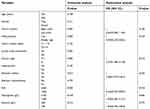 | Table 2 Univariate and multivariate analyses of prognostic factors for overall survival |
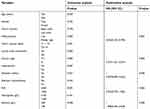 | Table 3 Univariate and multivariate analyses of prognostic factors for progression-free survival |
Discussion
It is well known that the tumor microenvironment, including inflammatory cells and host immune cells, are significantly associated with tumor progression. Circulating inflammatory immune cells, serum albumin and hemoglobin are considered potential prognostic indicators for predicting clinical outcomes of various malignancies. The inflammatory status of the tumor microenvironment is easily measured by using peripheral blood biomarkers. Therefore, peripheral blood biomarkers, such as PLR, albumin and hemoglobin, were considered useful prognostic indicators for clinical outcomes. Several studies have discussed the relationship between systemic inflammation and clinical outcomes, but these results were inconclusive in various malignancies.15–17
In the present study, we evaluated the prognostic values of PLR, albumin and hemoglobin in colon cancer, which extends and refines the relationship between peripheral blood biomarkers and clinical outcomes. We identified several clinicopathological features, such as tumor differentiation, clinical stage and diabetes mellitus, that affected clinical outcomes. Our results revealed that increased preoperative PLR was significantly associated with poor OS, which is an independent prognostic indicator for OS in colon cancer. Notably, PLR, albumin and hemoglobin did not correlate with PFS in multivariate analysis.
Several studies have demonstrated the prognostic value of PLR on survival for colorectal cancer and other tumors. Bailon-Cuadrado et al18 examined 201 patients with colon cancer who underwent curative resection and reported that increased PLR was negatively associated with OS and PFS. Peng et al19 performed a meta-analysis of 3542 patients with colorectal cancer and reported that increased PLR was significantly associated with poor OS and PFS. Portale et al13 investigated 152 patients with rectal cancer undergoing curative resection and reported that PLR was not an independent prognostic indicator. Chen et al12 examined 1080 patients with gastric cancer and reported that increased PLR was significantly associated with peritoneal metastasis. Our results support PLR an independent prognostic indicator for OS.
The exact mechanism of the relationship between systemic inflammation and tumor progression is not fully understood. The following theories contribute to the interpretation of the relationship. Platelets play an important role in tumor progression via the promotion of tumor proliferation, angiogenesis, degradation of the extracellular matrix and the release of vascular endothelial growth factors,11,20,21 and these cells protect tumor cells from cytolysis and promote metastasis.22 Anti-platelet drugs inhibit the invasiveness of tumor cells by decreasing metalloproteinase-9 secretion.23 In addition, the tumor microenvironment releases proinflammatory mediators, including IL-1, IL-3 and IL-6, which promote the proliferation of megakaryocytes.24 Megakaryocytes are platelet progenitor cells, which indicates that thrombocytosis reflects the status of systemic inflammation in the tumor microenvironment. Lymphocytes inhibit tumor proliferation and metastasis by enhancing cytotoxic cell death and cytokine production.25 Peripheral lymphocytopenia is marked by a decrease in CD4+ helper lymphocytes and an increase in CD8+ suppressor lymphocytes,26 which may lead to the insufficient immunological response and contribute to poor clinical outcomes after curative resection.
Malnutrition is significantly associated with increased postoperative morbidity and mortality.27 Malnutrition, which is partially mirrored by hypoalbuminemia, is involved in antitumor therapy and the host immune response. Serum albumin produced in the liver is the most abundant blood plasma protein, and it is often used to assess a patient’s nutritional status. Many studies have combined systemic inflammatory indicators and albumin to create new prognostic indicators, such as the prognostic nutritional index, the albumin-to-fibrinogen ratio,28 and the C-reactive protein-to-albumin ratio.29 These prognostic indicators are associated with clinical outcomes. Serum albumin is one of the most important indicators of nutritional status, and it is an independent prognostic indicator in various malignancies, such as gastric cancer,30 colorectal cancer,31 breast cancer,32 ovarian cancer33 and cervical cancer.34 Hemoglobin is a clinical characteristic that is a prognostic indicator in various malignancies, such as anal cancer35 and head and neck cancer.36,37 It was hypothesized that anaemia may enhance tumor hypoxia and increase tumor cell resistance to therapy to promote distant metastasis.35–37 Franco et al reported that preoperative hemoglobin level was an independent prognostic indicator for OS, but not PFS.35 Our results of the multivariate analyses did not reveal albumin or hemoglobin as independent prognostic indicators for OS or PFS. Our results are likely true and reliable based on our sample size of 300 patients who were only diagnosed with colon cancer.
It must be acknowledged that there were several limitations in the present study that should be considered. First, this study was a retrospective observational study in a single institution, and selection bias cannot be fully excluded. Second, the sample size was relatively small, and the results may not be generalized. Third, we used the same cut-off levels for both OS and PFS to simplify the calculation, which may be less powerful than the use of respective cut-off levels. Fourth, several factors, such as vascular invasion, perineural invasion and microsatellite instability, were also reported as prognostic indicators. These factors were not evaluated in our study because of a deficiency of the abovementioned data. Therefore, our results should be carefully interpreted.
Conclusion
In conclusion, we identified preoperative PLR as an independent prognostic indicator for OS in patients with stage I-III colon cancer who underwent curative resection. Decreased preoperative PLR was significantly associated with better OS. Nevertheless, large-scale, better-designed studies are needed to evaluate the prognostic indicators and elucidate the exact mechanisms of systemic inflammation, nutrition status and clinical outcome.
Author contributions
ZGL, YZ and ZFX designed the study and wrote the manuscript. ZGL, YQH, YPC and RZ retrieved data from the database. XTW interpreted the data and proofread the final version. All authors contributed to data analysis, drafting and revising the article, gave final approval of the version to be published, and agree to be accountable for all aspects of the work.
Disclosure
The authors report no conflicts of interest in this work.
References
1. Torre LA, Bray F, Siegel RL, Ferlay J, Lortet-Tieulent J, Jemal A. Global cancer statistics, 2012. CA. 2015;65(2):87–108. doi:10.3322/caac.21262
2. O’Connell JB, Maggard MA, Ko CY. Colon cancer survival rates with the new American Joint Committee on Cancer sixth edition staging. J Natl Cancer Inst. 2004;96(19):1420–1425. doi:10.1093/jnci/djh275
3. Fichtner-Feigl S, Kesselring R, Strober W. Chronic inflammation and the development of malignancy in the GI tract. Trends Immunol. 2015;36(8):451–459. doi:10.1016/j.it.2015.06.007
4. Balkwill F, Mantovani A. Inflammation and cancer: back to Virchow? Lancet. 2001;357(9255):539–545. doi:10.1016/S0140-6736(00)04046-0
5. Diakos CI, Charles KA, McMillan DC, Clarke SJ. Cancer-related inflammation and treatment effectiveness. The Lancet Oncol. 2014;15(11):e493–503. doi:10.1016/S1470-2045(14)70263-3
6. Sun X, Liu X, Liu J, et al. Preoperative neutrophil-to-lymphocyte ratio plus platelet-to-lymphocyte ratio in predicting survival for patients with stage I-II gastric cancer. Chin J Cancer. 2016;35(1):57. doi:10.1186/s40880-016-0122-2
7. Chan JC, Chan DL, Diakos CI, et al. The lymphocyte-to-monocyte ratio is a superior predictor of overall survival in comparison to established biomarkers of resectable colorectal cancer. Ann Surg. 2017;265(3):539–546. doi:10.1097/SLA.0000000000001743
8. Lee BM, Chung SY, Chang JS, Lee KJ, Seong J. The neutrophil-lymphocyte ratio and platelet-lymphocyte ratio are prognostic factors in patients with locally advanced pancreatic cancer treated with chemoradiotherapy. Gut Liver. 2018;12(3):342–352. doi:10.5009/gnl17216
9. Peng J, Li H, Ou Q, et al. Preoperative lymphocyte-to-monocyte ratio represents a superior predictor compared with neutrophil-to-lymphocyte and platelet-to-lymphocyte ratios for colorectal liver-only metastases survival. Onco Targets Ther. 2017;10:3789–3799. doi:10.2147/OTT.S140872
10. Koh CH, Bhoo-Pathy N, Ng KL, et al. Utility of pre-treatment neutrophil-lymphocyte ratio and platelet-lymphocyte ratio as prognostic factors in breast cancer. Br J Cancer. 2015;113(1):150–158. doi:10.1038/bjc.2015.183
11. Kono SA, Heasley LE, Doebele RC, Camidge DR. Adding to the mix: fibroblast growth factor and platelet-derived growth factor receptor pathways as targets in non-small cell lung cancer. Curr Cancer Drug Targets. 2012;12(2):107–123.
12. Chen XD, Mao CC, Wu RS, et al. Use of the combination of the preoperative platelet-to-lymphocyte ratio and tumor characteristics to predict peritoneal metastasis in patients with gastric cancer. PLoS One. 2017;12(4):e0175074. doi:10.1371/journal.pone.0175074
13. Portale G, Cavallin F, Valdegamberi A, Frigo F, Fiscon V. Platelet-to-lymphocyte ratio and neutrophil-to-lymphocyte ratio are not prognostic biomarkers in rectal cancer patients with curative resection. J Gastrointestinal Surg. 2018;22:1611–1618. doi:10.1007/s11605-018-3781-2
14. Ge LN, Wang F. Prognostic significance of preoperative serum albumin in epithelial ovarian cancer patients: a systematic review and dose-response meta-analysis of observational studies. Cancer Manag Res. 2018;10:815–825. doi:10.2147/CMAR.S161876
15. Min GT, Wang YH, Yao N, et al. The prognostic role of pretreatment platelet-to-lymphocyte ratio as predictors in patients with colorectal cancer: a meta-analysis. Biomark Med. 2017;11(1):87–97. doi:10.2217/bmm-2016-0181
16. Gu XB, Gao XS, Qin SB, et al. Elevated platelet to lymphocyte ratio is associated with poor survival outcomes in patients with colorectal cancer. PLoS One. 2016;11(9). doi:10.1371/journal.pone.0163523
17. Zhou X, Du YP, Huang ZB, et al. Prognostic value of PLR in various cancers: a meta-analysis. PLoS One. 2014;9(6):e101119. doi:10.1371/journal.pone.0101119
18. Bailon-Cuadrado M, Choolani-Bhojwani E, Tejero-Pintor FJ, et al. Preoperative platelet-lymphocyte ratio is an independent factor of poor prognosis after curative surgery for colon cancer. Updates Surg-Italy. 2018;70(1):33–39. doi:10.1007/s13304-017-0503-3
19. Peng HX, Lin K, He BS, et al. Platelet-to-lymphocyte ratio could be a promising prognostic biomarker for survival of colorectal cancer: a systematic review and meta-analysis. FEBS Open Bio. 2016;6(7):742–750. doi:10.1002/2211-5463.12083
20. Dvorak HF, Brown LF, Detmar M, Dvorak AM. Vascular permeability factor/vascular endothelial growth factor, microvascular hyperpermeability, and angiogenesis. Am J Pathol. 1995;146(5):1029–1039.
21. Egan K, Crowley D, Smyth P, et al. Platelet adhesion and degranulation induce pro-survival and pro-angiogenic signalling in ovarian cancer cells. PLoS One. 2011;6(10):e26125. doi:10.1371/journal.pone.0026125
22. Nieswandt B, Hafner M, Echtenacher B, Mannel DN. Lysis of tumor cells by natural killer cells in mice is impeded by platelets. Cancer Res. 1999;59(6):1295–1300.
23. Suzuki K, Aiura K, Ueda M, Kitajima M. The influence of platelets on the promotion of invasion by tumor cells and inhibition by antiplatelet agents. Pancreas. 2004;29(2):132–140.
24. Klinger MH, Jelkmann W. Role of blood platelets in infection and inflammation. J Interferon Cytokine Res. 2002;22(9):913–922. doi:10.1089/10799900260286623
25. Mantovani A, Allavena P, Sica A, Balkwill F. Cancer-related inflammation. Nature. 2008;454(7203):436–444. doi:10.1038/nature07205
26. Menges T, Engel J, Welters I, et al. Changes in blood lymphocyte populations after multiple trauma: association with posttraumatic complications. Crit Care Med. 1999;27(4):733–740.
27. Obermair A, Simunovic M, Isenring L, Janda M. Nutrition interventions in patients with gynecological cancers requiring surgery. Gynecol Oncol. 2017;145(1):192–199. doi:10.1016/j.ygyno.2017.01.028
28. Li SQ, Jiang YH, Lin J, et al. Albumin-to-fibrinogen ratio as a promising biomarker to predict clinical outcome of non-small cell lung cancer individuals. Cancer Med-Us. 2018;7(4):1221–1231. doi:10.1002/cam4.1428
29. Zhang WW, Liu KJ, Ye B, Liang WJ, Ren YZ. Pretreatment C-reactive protein/albumin ratio is associated with poor survival in patients with stage IB-IIA cervical cancer. Cancer Med-Us. 2018;7(1):105–113. doi:10.1002/cam4.1270
30. Toiyama Y, Yasuda H, Ohi M, et al. Clinical impact of preoperative albumin to globulin ratio in gastric cancer patients with curative intent. Am J Surg. 2017;213(1):120–126. doi:10.1016/j.amjsurg.2016.05.012
31. Artac M, Uysal M, Karaagac M, et al. Prognostic impact of neutrophil/lymphocyte ratio, platelet count, CRP, and albumin levels in metastatic colorectal cancer patients treated with FOLFIRI-Bevacizumab. J Gastrointest Cancer. 2017;48(2):176–180. doi:10.1007/s12029-016-9879-4
32. Hwang KT, Chung JK, Roh EY, et al. Prognostic influence of preoperative fibrinogen to albumin ratio for breast cancer. J Breast Cancer. 2017;20(3):254–263. doi:10.4048/jbc.2017.20.3.254
33. Ayhan A, Gunakan E, Alyazici I, Haberal N, Altundag O, Dursun P. The preoperative albumin level is an independent prognostic factor for optimally debulked epithelial ovarian cancer. Arch Gynecol Obstet. 2017;296(5):989–995. doi:10.1007/s00404-017-4511-9
34. Xiao Y, Ren YK, Cheng HJ, Wang L, Luo SX. Modified Glasgow prognostic score is an independent prognostic factor in patients with cervical cancer undergoing chemoradiotherapy. Int J Clin Exp Pathol. 2015;8(5):5273–5281.
35. Franco P, Montagnani F, Arcadipane F, et al. The prognostic role of hemoglobin levels in patients undergoing concurrent chemo-radiation for anal cancer. Radiat oncol. 2018;13(1):83. doi:10.1186/s13014-018-1035-9
36. Nordsmark M, Bentzen SM, Rudat V, et al. Prognostic value of tumor oxygenation in 397 head and neck tumors after primary radiation therapy. An international multi-center study. Radiother Oncol. 2005;77(1):18–24. doi:10.1016/j.radonc.2005.06.038
37. Vaupel P, Mayer A, Hockel M. Impact of hemoglobin levels on tumor oxygenation: the higher, the better? Strahlenther Onkol. 2006;182(2):63–71. doi:10.1007/s00066-006-1543-7
 © 2019 The Author(s). This work is published and licensed by Dove Medical Press Limited. The full terms of this license are available at https://www.dovepress.com/terms.php and incorporate the Creative Commons Attribution - Non Commercial (unported, v3.0) License.
By accessing the work you hereby accept the Terms. Non-commercial uses of the work are permitted without any further permission from Dove Medical Press Limited, provided the work is properly attributed. For permission for commercial use of this work, please see paragraphs 4.2 and 5 of our Terms.
© 2019 The Author(s). This work is published and licensed by Dove Medical Press Limited. The full terms of this license are available at https://www.dovepress.com/terms.php and incorporate the Creative Commons Attribution - Non Commercial (unported, v3.0) License.
By accessing the work you hereby accept the Terms. Non-commercial uses of the work are permitted without any further permission from Dove Medical Press Limited, provided the work is properly attributed. For permission for commercial use of this work, please see paragraphs 4.2 and 5 of our Terms.

